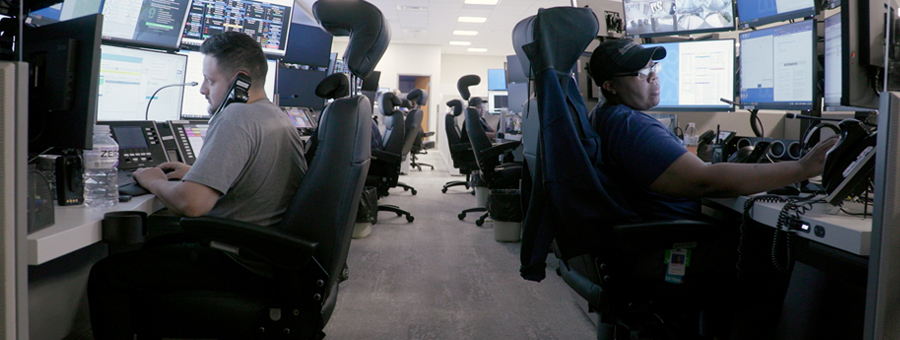Automation, predictive analytics, artificial intelligence—once only seen in science fiction, these futuristic technologies are increasingly becoming realities. Children’s hospitals are integrating them into the fabric of their organizations to make them “smarter.”
Smart hospitals leverage technology to automate menial chores, freeing team members to work at the pinnacle of their training. They use algorithms to crunch mountains of data and predict outcomes, informing important decisions at every level of the organization. They streamline processes to improve the quality and efficiency of patient care.
There’s no definitive blueprint for building a smart hospital, but the possibilities—and potential benefits—are seemingly endless. Here are the technological journeys of three children’s hospitals in their quest to enhance the patient and employee experience, advance patient care and empower the workforce.
Navigating through space and time
The team of highly trained professionals attend to their stations in the 6,000-square-foot operations center, consuming a constant stream of data from a massive wall of charts, graphs and maps. Their mission: Ensure the people in their care get home as quickly and safely as possible. While this buzzing nerve center could be mistaken for NASA mission control, it’s actually the Patient Progression Hub at Children’s Mercy Kansas City.
Children’s Mercy launched the hub in April 2023 to streamline a patient’s care from their initial referral through their discharge. Aggregating real-time data from multiple systems into one command center, the Patient Progression Hub uses artificial intelligence and predictive analytics to optimize patient care flow. The state-of-the-art technology provides improvements across the care cycle:
- Data-informed staffing. AI functionality provides highly accurate census projections up to 48 hours in advance, enabling Children’s Mercy to align staffing levels with patient demand.
- Bed management. Managing bed assignments from one central location streamlines prioritization and shortens wait times for transfers.
- Avoiding delays. Real-time data alerts hub staff to head off potential delays across the organization, such as reducing wait times for patients in the Emergency Department or the Post-Anesthesia Care Unit (PACU) who are awaiting an inpatient bed.
- Discharge process. Up-to-the-minute patient tracking and predictive analytics help clinicians streamline the tests and procedures needed to discharge a patient, freeing up a bed for a new patient more quickly.
A vital component of the Patient Progression Hub is having all key stakeholders in the same space, sharing the same real-time information and breaking down the silos that bog down patient flow. “You’ve got all of the right people—physician, nurse, care management, transfer center, nursing supervisors, EVS—sitting together to problem solve and make things happen,” says Jennifer Watts, M.D., MPH, emergency medicine physician and chief patient progression medical officer at Children’s Mercy.
Since implementing, the Hub has created capacity for approximately 67 additional patients annually, equating to 232 projected beds saved.
In addition to improved operations, she traces an intangible benefit to the hub. “At a time when burnout is so high in health care and we have people struggling to stay in the field, I saw people become reinvigorated when we launched the hub—they want to be part of the solution,” Watts says. “It’s sparked innovation and joy in people we didn’t have before.”
Watts expects that enthusiasm to last since Children’s Mercy is only scratching the surface of the technology’s capabilities. The vast data-gathering and predictive analysis functionalities of the hub software could lead to broader process improvements at the hospital that profoundly impact community health as a whole.
“The future of this technology for us is really endless,” says Stephanie Meyer, RN, MS-FNP, NEA-BC, senior vice president and chief nursing officer. “To be able to look at health disparities and where we need to put more resources and how that’s going to affect our overall plans of care is a game changer. I think this can transform pediatric health care.”
Building tomorrow’s hospital today
It’s not unusual for a hospital’s chief information officer to strive for the “hospital of the future” by deploying today’s newest technologies. It’s a bit more complicated for Denise Zabawski. She’s tasked with forecasting the technological needs of a new inpatient hospital tower that’s still years away—so she’s quite literally building a hospital of the future.
“We won’t be moving in until late 2028, so we’re trying to anticipate where technology is going to go in five years,” says Zabawski, vice president and chief information officer at Nationwide Children’s Hospital in Columbus, Ohio. “It makes planning even more challenging because we don’t know the pace of innovation and transformation that new products are going to bring to the market.”
The new facility is the centerpiece of a $3.3-billion expansion project at Nationwide Children’s. It will sit adjacent to the hospital’s current tower and is planned to be slightly larger than the existing 750,000- square-foot, 302-bed structure. Although Zabawski and her team are early in the planning stages, the new tower will employ cutting-edge technology.
Robotics
Autonomous guided vehicles (AGVs) will move carts carrying medical supplies, linens and food. Dedicated elevators and corridors will accommodate the AGVs so they don’t interfere with patient and visitor traffic.
Robots also will clean the floors and assist in providing security services. Camera-enabled units will guard some of the hospital’s many secondary entrances and alert protective services officers.
Rooms of the future
Each room will be outfitted with a digital footwall, similar to a large, wall-mounted tablet. Many patient and family needs will be met through the interactive wall, such as pharmacy, food orders and interpreter services. School-age patients can join a classroom via the footwall, or a parent can virtually visit with the care team during rounding.
On the clinical side, the footwall will enable virtual patient sitters and remote monitoring. It will also provide a snapshot of all the patient’s medical equipment data in real time, which artificial intelligence will assess to predict deterioration before it occurs.
“We want to build a patient room that is high tech without looking high tech. I think that’s a big challenge,” Zabawski says. “We want the room to be comforting and calming and have space for families to stay and be with their child.”
Enhanced streamlining
Zabawski wants to build functionality into the new space to make the hospital more convenient for both families and staff members. One way she’ll do this is by using virtual assistants to pull insurance paperwork and write discharge plans, freeing the nursing staff to spend time at the bedside.
“It’s a common thing we hear across the health care industry: Patients and families don’t feel like care providers are paying attention to them because they’re so busy on the computer, and the providers feel the same way,” Zabawski says. “They’ve got to get their documentation done, but that’s not where they want to be—they want to provide patient care.”
Another example is streamlining the food service. “Everyone seems to hit the cafeteria at the same time. No matter how well you design it, there are always lines and backlogs,” Zabawski says. “We’re looking at an option where you can get an alert when your food is ready and go take it out of a locker.”
Planning for the future
Because the new tower is years to come, the hospital is running pilot programs in the existing inpatient tower for many of these technological innovations. Piloting the security robots, self-service food lockers and aggregated patient data from the in-room medical equipment lets the hospital to determine if a technology will be useful and helps iron out any bugs.
High-tech hospital in a tech mecca
For Myra Davis, it was a match made in heaven. The plans to open a 365,000-square-foot, 52-bed hospital in the burgeoning technology hub of Austin, Texas, provided the perfect opportunity to build a smart facility.
“We know the community is really tech friendly and tech savvy,” says Davis, senior vice president and chief information and innovation officer at Texas Children’s Hospital in Houston. “With that as a backdrop, we wanted to advance the technology with the opportunities we would have there.”
For the new hospital in the “new Silicon Valley,” Davis and her team designed a state-of-the-art technology experience for patients, families, employees and providers by integrating a mix of emerging technologies and new applications of existing tech. When the hospital opens its doors in February 2024, it will include these technological features:
Asset optimization
Chips embedded in medical equipment and devices will automate asset management. Currently, clinicians and engineering teams must manually locate available assets, such as smart pumps or monitors. Not only will the chips provide access to real-time equipment location data, they’ll also send alerts when a machine requires service. Additionally, Texas Children’s plans to leverage predictive analysis of the usage data collected by each asset to ensure equipment is proactively placed in areas where staff use it most frequently.
Simulation center
Working closely with clinicians, the Texas Children’s technology team will use its SIMLab Innovation Center to simulate the integration of new technologies like virtual reality and artificial intelligence into its care model. “This prevents the deployment of technology for technology’s sake,” Davis says. “It’s an opportunity to integrate it and learn while maintaining the focus on why we’re all here: the patient.”
Wi-Fi 6E architecture
According to Davis, it’s “the rug that supports all the other digital experiences” at the Austin hospital. Texas Children’s is constructing an extensive Wi-Fi 6E network throughout the campus, extending coverage from the parking lot to every corner of the hospital building, ensuring hospital visitors and staff can communicate with the outside world anytime, anywhere. Wi-Fi 6E is the fastest Wi-Fi currently available and reliably supports more users at once, including in dense and congested environments.
Digital experience
Each audio-visual screen in the hospital will be supported by a next-generation, context-aware digital delivery network. This portal pulls together all data streams, including TV, movies, patient EMR, dining services and educational material, into one user interface. Although each patient room is individually controlled, hospital staff can display specific channels on groups of monitors, such as The Weather Channel on all hallway monitors during a weather event or an important safety message on all monitors.
Smart alarms
Traditional patient alarm systems elicit numerous false alarms by examining vital signs only in isolation. A smart alarm system uses an algorithm to account for multiple vital signs in monitoring patients and alerting care providers. The multi-level alarm more effectively conveys the clinical severity of the patient based on the parameters established by the care team, resulting in fewer false alarms.
Critical care transport
Texas Children’s ambulances will be equipped with dual-cell antennas to ensure connectivity along with secure VPN that includes the hospital’s EMR and video connection with physicians on site. The video hookup allows doctors to help the paramedic team care for the patient before they arrive at the hospital.


